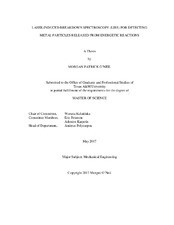| dc.description.abstract | The objective of this work is to characterize emissions from solid propellants using a non-intrusive optical diagnostic method, primarily focusing on the release of the metallic species of aluminum (Al), copper (Cu), lead (Pb), and mercury (Hg) during energetic reactions. The primary motivation for developing such diagnostic methods is that particulate matter released to the air from energetic reactions can cause adverse health effects, such as pulmonary and cardiovascular disease, particulate matter-induced allergy, and cancer. The enabling technology used for this research study is Laser-Induced Breakdown Spectroscopy (LIBS), which is an elemental, analytical technique that uses high-intensity laser pulses to generate a plasma in a medium where the composition is to be detected. Light emitted from this plasma is then collected and dispersed using a spectrometer onto a CCD array. The elemental composition can be determined based on characteristic spectral lines detected and their relative intensities. Two LIBS schemes were used during the current experiments: one using a 10-nanosecond (ns) pulse-duration, 10- Hz repetition-rate, neodymium-doped yttrium aluminum garnet (Nd:YAG) laser and the other using an 80-femtosecond (fs) pulse-duration, 1-kHz repetition-rate, amplified Ti:Sapphire laser system.
Before attempting to detect the metallic species in the gas-phase exhaust region during the combustion of laboratory-scale propellant sticks, initial experiments of laser pulse energy dependence and plasma decay time were performed using solid target plates of Al, Cu and Pb. These initial experiments were conducted to determine the optimum laser parameters and signal collection conditions. Subsequent experiments were conducted during combustion events of hydroxyl-terminated polybutadiene/ammonium perchlorate (HTPB/AP) propellant samples doped with known quantities of metals. The ns-LIBS scheme was capable of detecting Al LIBS signals corresponding to the samples with predetermined quantities of Al in the 5–16% range by mass. An aluminum metal concentration study was also performed, which showed that a propellant strand with a higher mass percentage of aluminum is more likely to have a LIBS signal until up to a point where the gas-phase reaction zone begins to act like a homogeneous medium. A comparison of LIBS detection between a ns Nd:YAG laser and fs Ti:Sapphire laser was also performed. While the LIBS scheme using the 10-ns, 10-Hz Nd:YAG laser pulses could not detect any other metal species besides aluminum, the 80-fs, 1-kHz Ti:Sapphire laser was able to detect characteristic signals from the metallic additives: aluminum, copper, lead (from the base metal as well as from lead stearate [(C17H35COO)2Pb], a common additive for altering the reaction rate), and mercury chloride (Hg2Cl2) at mass percentages in the range of 2–16% by mass in the initial propellant mix. | en |


